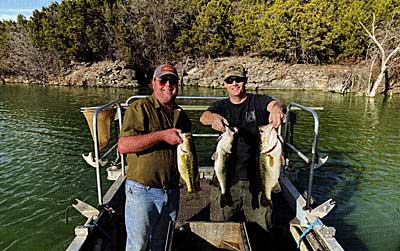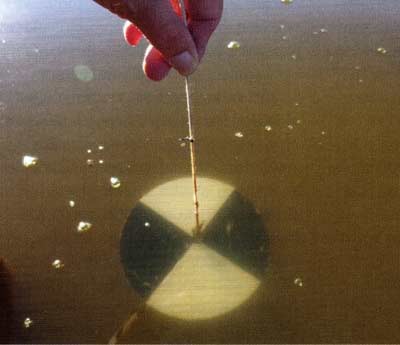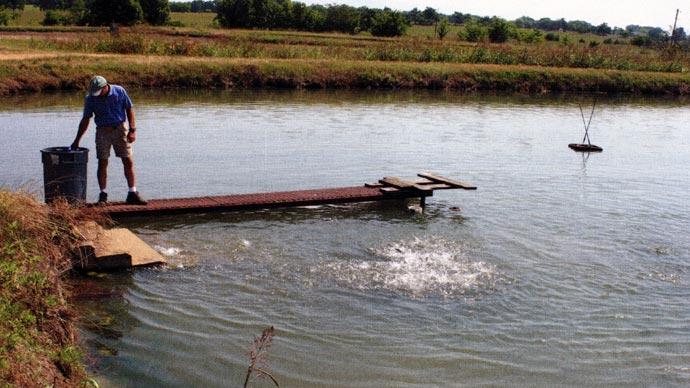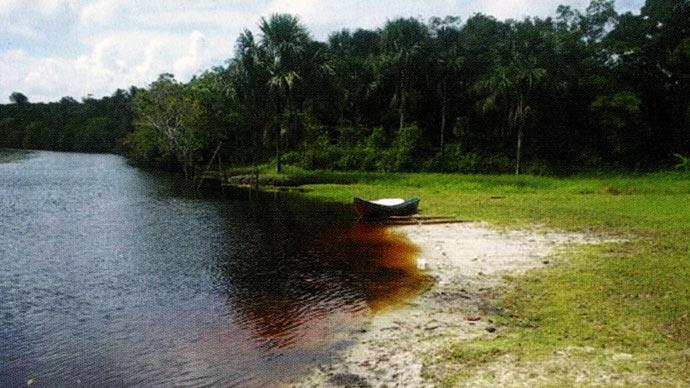
It turns out in life that sometimes, two opposite ideas can seem valid simultaneously.
Some pond management concepts can be an example of this.
The opposites: most people prefer clean, clear water to swim and other getting-wet forms of fun, but fishing is best in productive water. Productive water is defined in part by its lack of clarity. Water won't be crystal clear, and there will be plants and maybe some algae.
Managing a multi-purpose recreational pond may require some compromise by the participants. Understanding the needs of the pond and the needs of the people using the pond will help us understand why a little compromise can mean a lot of fun. Can water clarity be measured? Determining the transparency of water is a way of quantifying (giving a number to) the visual appearance of pond water so it can be compared to other days or other bodies of water. A Secchi disk is a black and white disc that is 8" in diameter (the measurement all the way across, the radius is the measurement from the center to the edge), and the disc is used to measure water transparency. The disc is dropped slowly down through the water column on a rope, and the observer notes when the disc disappears. The depth the Secchi disc disappears is the depth where light can no longer penetrate (go through) the water, hit the disc, and bounce back to the observer's eye. The depth the disk disappears is measured on the rope and can be recorded for future information and comparisons.
Why go through all that trouble? One of the key elements of scientific observation is that a reproducible value, or number, is given to observations. For example, one person's clear water may be another person's "ewwwwww gross!" A Secchi disk depth is a number, not an opinion, and with a bit of practice, the observer can reproduce (repeat) the same answer in the same conditions. This means that the Secchi disc measurement of transparency should not be affected by the observer's opinion or biases about the water they are measuring. An example of a bias is not liking a food because it looks gross without even trying to see if it tastes good. An example of an opinion is temperature, is 80-degree water warm or cold? Some people say cold, and some say wonderfully invigorating.
It's easy to understand why swimmers prefer clean, clear water. Very few people enjoy wading through thick tangly weeds while walking in a pond, nor do many enjoy swimming in dark-colored water that leaves their hair and clothes smelling like a cross between wet dog and funky compost. However, in the art of compromise, we must understand both sides of the story. So why does good fishing require a productive (not the best quality for swimming) pond? The short answer is food—fish need to eat to grow big.

Like all food webs, a pond's food web depends on primary producers to get it jump-started. On land, plants are the primary producers, and they typically grow in soil, where they get nutrients while they use sunlight to create energy. In a pond, phytoplankton provide most of the primary production. The submerged rooted (commonly known as "eeeewww-seaweed') plants provide shelter for many fish but only provide food to a few very specialized and not-very-popular-to-fish-for species. Phytoplankton are microscopic (tiny) photosynthetic semi-buoyant plants that thrive in the water column of a pond. Since they are photosynthetic, they require sunlight to live and grow and, therefore, can only live where sunlight can penetrate the water.
Like all plants, phytoplankton also need nutrients in addition to light to grow, and they get their nutrients by bumping into them while moving around in the water. This means phytoplankton grow best in water with sediments and decaying bits of matter floating or dissolving around in the same places with ample light.
Therefore, there is a relationship between a Secchi disc measurement and productivity (barring a just plain muddy water situation). A productive pond will have stuff clouding up the water, and the Secchi disc reading will be smaller. Conversely, a clear pond has a larger Secchi disc reading because there are fewer phytoplankton and less nutrients in the water, which means the food web will not have good primary production.
A food web without plenty of primary producers (a clear pond) does not have adequate food. Without food, the smallest consumers, like zooplankton (microscopic consumers), baby fish, bait fish, insects, and many more, will have nothing to eat. Likewise, big fish will not have enough to eat and grow without plenty of small consumers to hunt and eat.
This brings us back to the beginning; the ingredients for a great swimming pond are not the same as those for the best fishing pond, but luckily, with a little compromise and careful planning, ponds can and often do meet both needs!
Ponds can have zones (spaces) designed for productivity and happy fish while having other zones that are great for swimming. Solutions like a dock and swim platforms make this even easier because swimmers can get to the deep, clear water, leaving the productive edges for the fish and the fishing. Once again, our ponds provide amazing life lessons!
Reprinted with permission from Pond Boss Magazine



